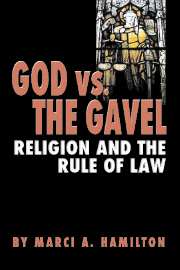Book contents
- Frontmatter
- Contents
- Acknowledgments
- Foreword, by the Hon. Edward R. Becker
- GOD VS. THE GAVEL: RELIGION AND THE RULE OF LAW
- PART ONE WHY THE LAW MUST GOVERN RELIGIOUS ENTITIES
- PART TWO THE HISTORY AND DOCTRINE BEHIND THE RULE THAT SUBJECTS RELIGIOUS ENTITIES TO DULY ENACTED LAWS
- 8 Boerne v. Flores: The Case That Fully Restored the Rule of Law for Religious Entities
- 9 The Decline of the Special Treatment of Religious Entities and the Rise of the No-Harm Rule
- 10 The Path to the Public Good
- Epilogue
- Notes
- Index
9 - The Decline of the Special Treatment of Religious Entities and the Rise of the No-Harm Rule
Published online by Cambridge University Press: 24 July 2009
- Frontmatter
- Contents
- Acknowledgments
- Foreword, by the Hon. Edward R. Becker
- GOD VS. THE GAVEL: RELIGION AND THE RULE OF LAW
- PART ONE WHY THE LAW MUST GOVERN RELIGIOUS ENTITIES
- PART TWO THE HISTORY AND DOCTRINE BEHIND THE RULE THAT SUBJECTS RELIGIOUS ENTITIES TO DULY ENACTED LAWS
- 8 Boerne v. Flores: The Case That Fully Restored the Rule of Law for Religious Entities
- 9 The Decline of the Special Treatment of Religious Entities and the Rise of the No-Harm Rule
- 10 The Path to the Public Good
- Epilogue
- Notes
- Index
Summary
There has been an ongoing dialectic between religious entities, the law, and the public good for centuries, and it has tended from strong privileges for religious entities toward the application of the rule of law to them. This play of power has yielded a construct that incorporates lessons learned. As Justice Oliver Wendell Holmes said, “the life of the law has not been logic: it has been experience.”
There was a time in Anglo-American history when established religious entities were sovereign and the clergy enjoyed special treatment under the law. It would have come as no surprise to anyone that the established religious institution was immune to the requirements of the law or that clergy were relieved of its requirements while all other citizens were not. A citizen could be put to death for raping a child, while a clergy member could commit the same crime and be sentenced to a year at a monastery. That era, however, was centuries ago. Today, the rule in the United States is that every entity – including a religious entity – is subject to the law.
This chapter places the United States' religious liberty principles in historical context. The contemporary system – reaffirmed in Employment Div. v. Smith and Boerne v. Flores – is not a 20th-century concoction, but rather the result of centuries of development.
There are, of course, many reasons to invoke history; the purpose here is two-fold.
- Type
- Chapter
- Information
- God vs. the GavelReligion and the Rule of Law, pp. 238 - 272Publisher: Cambridge University PressPrint publication year: 2005

